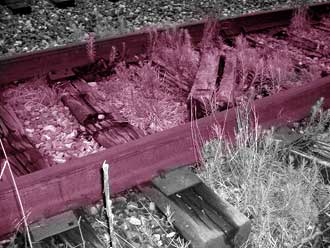 | |
| { Trading Pedestals at Exit Three } Kate Lukaszewicz
The tunnel squats, unassumingly, just across from exit three on Route 28. And it's more than a thoroughfare for trains; it serves as a gallery showcase, a target range, even a bordello. Aspiring artists with nothing better to do consider vandalism their something better to do, and decorate the otherwise dull concrete with obnoxious spray-painted hues of traffic-light green and Eighties'-eye-shadow blue, mocking the rocks of various skin tones: brown, red, peach, cadaver gray. Pebbles wedge themselves into the grooves of shoes, but larger stones are suitable for launching at abandoned beer bottles, as though there were a war on between drunken teenagers and a dirtied glass army of grimy clear bottles with the occasional green Rolling Rock thrown in for variety. Potentially poisonous Trojans lie among these cheap diamonds and emeralds, discarded as easily as virtue or the simply satisfactory girl. I was introduced to the tunnel by a boy, one of the aforementioned vandals, who, at his most eloquent and best inspired, could commit to no more than admitting that he liked me better than his computer. (He was the familiar kind of boy that ovaries ache for, but I could appreciate him for little more than the fact that he was exothermic and my hands were always icy.) It was "our" tunnel. It was where I could find him if his mother didn't know where he was. I would cross the highway and slide down the pebbly hill across the broken tracks (one set is fully intact and functional, slick and black, while the other is decrepit; the wood is there, then gone, and then there again, like the second place runner in a marathon desperate to win—falling back then sprinting ahead), and he would be there, the discerning look on his face replaced by a sheepish smile when I caught him red-handed (or green- or blue-handed, depending on the can). I cared not so much for his vandal ways. I preferred the classic approach of his camera. | |
 I don't really care for bicycles so much, so I'm somewhat of a disgruntled Millvale citizen. I like the train tunnel that hides out next to the highway. I like the grit and stones, the rusty spikes, busted bottles with their jagged edges providing the look of avant-garde vases. But somebody's been cleaning it all up as part of the Rails to Trails project, because the less-adventurous people of the Pittsburgh community want to pedal through a hazard-free terrain, one flanked by pristine walls, with no obstructions on the path.
I don't really care for bicycles so much, so I'm somewhat of a disgruntled Millvale citizen. I like the train tunnel that hides out next to the highway. I like the grit and stones, the rusty spikes, busted bottles with their jagged edges providing the look of avant-garde vases. But somebody's been cleaning it all up as part of the Rails to Trails project, because the less-adventurous people of the Pittsburgh community want to pedal through a hazard-free terrain, one flanked by pristine walls, with no obstructions on the path.